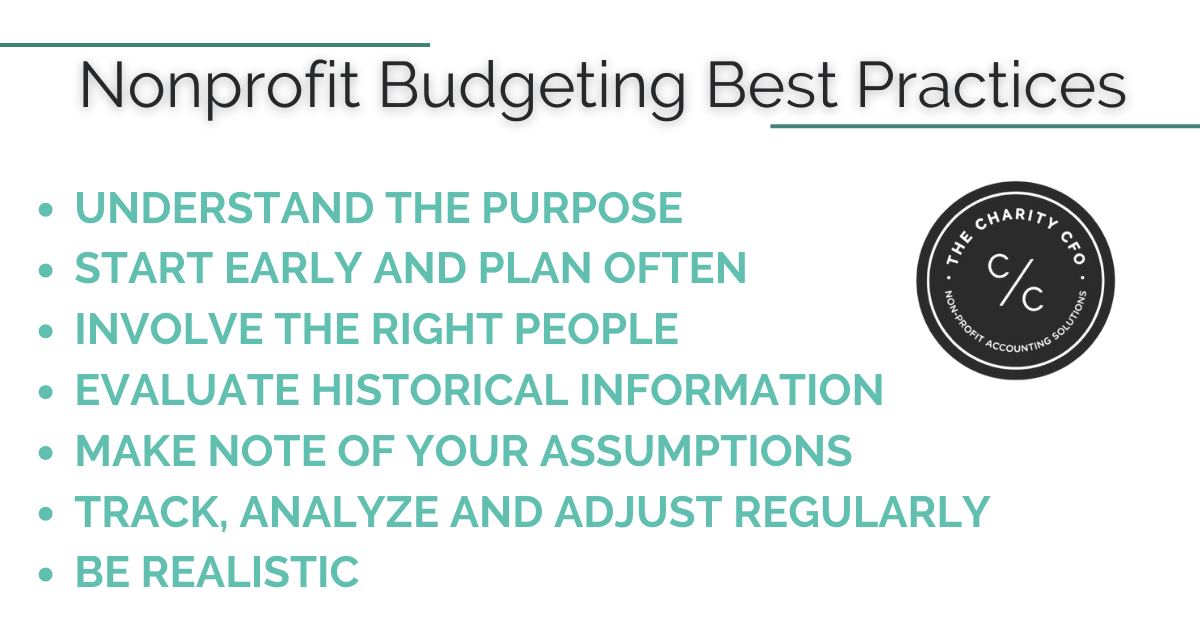Nonprofit budgeting best practices are often the difference between success and failure for the organization.
Budgeting is a crucial element of understanding the financial health of your organization. Budgeting for nonprofits is very different from for profits, and a well-developed budgeting process can provide meaningful insight into the strength of your organization and your progress toward your mission. It also allows for better communication and transparency with employees who are striving for the same goals.
While nonprofit budgeting can seem daunting and complex, it doesn’t have to be. We’ve outlined some nonprofit budgeting best practices to enhance your budgeting skills and help you strategically and effectively plan your programming and reach your goals.
Nonprofit Budgeting Best Practices
Understand the purpose
Understanding the purpose of your organization and, by extension, your budget is the most important thing you can do when creating your annual budget. What is your mission and what goals and programs are going to help you get there?
As nonprofits must specifically account for the use of every dollar, keeping your purpose as your north star will help you tremendously when creating your budget. From there you can further determine how the budget will be used, who needs to be included, and how you can utilize the budget to make strategic decisions moving forward. Knowing the answers to these questions will help you focus and create an effective budget.
Start early and plan often
Planning is key. It takes time to get a budget right. Starting your budgeting process early will save a lot of headaches. By thinking about your budget early on, you can identify key people in your organization to provide information regarding the data, activities, income and expenses necessary to create a nonprofit operating budget.
Put calendar invites in place to begin discussions, ensuring that when the time comes to compile the budget and present to the Board, proper thought and care has been put into the assumptions used.
Involve the right people
Another benefit to planning early is that you have time to make sure the right people are properly included. In addition to the Board and leadership, it’s important to include other key employees in the process. These are usually the ones who have their hands on the pulse of the organization. They operate in the day to day and are able to provide insight into how specific programs and initiatives are going.
By being transparent and including key employees in the process, you can identify areas of improvement and pain points, creating a more effective budget. This also provides opportunity to discuss with the Board strategic opportunities, making the most use of all the time you’ve spent creating your budget.
Evaluate historical information
If you’ve been operating for a while, then you should already have a great start in creating your nonprofit’s budget. Using historical information is the best starting point to begin your budgeting process. Take the information from prior year actuals and expand upon it, using the takeaways gathered from key employees. By combining historical data with real time assumptions you are in a great place to pull together a first draft of your budget.
If you’re starting from scratch, check out our Beginner’s Guide to Nonprofit Budgeting.
Make note of your assumptions
Using historical information is a great place to start, but it’s important to keep track of what assumptions you are using to calculate the actual number you are presenting. Tracking these assumptions makes it easier to identify what happened when actual numbers don’t match your estimates. Understanding these assumptions makes budget analysis and strategic decision-making much easier.
Track, analyze and adjust regularly
Once you’ve created a budget, it’s important that you don’t just sit on it until next year. Take the time to track your budget to actuals and analyze the variances monthly. Looking at your assumptions can be helpful in explaining any discrepancies, as you now have more information regarding how the year is progressing. Variances should be expected. It’s wise to adjust your budget based on actuals and create an updated projection for the remainder of the year. Budgets are only as good as the information available and, as the year goes on, you gain more insight into operations.
Be realistic
While the last few years have seen huge upticks in donor giving, it’s still important to remain realistic. With over 1.5 million nonprofits in the US alone, there’s still steep competition. Understanding your organization’s place in the current environment, knowing your donor profile, and setting realistic goals, both financially and programmatically, puts you on more solid ground, ensuring that your organization can continue doing good now and in the future.
These nonprofit budgeting best practices are high level and we know there’s a lot that goes into nonprofit budgeting. If you’re looking for help in creating an efficient and effective budget, The Charity CFO has resources and professionals to support you, so you can focus on your mission.

Do You Struggle to Make Sense of Your Financial Statements?
Get our FREE GUIDE to nonprofit financial reports, featuring illustrations, annotations, and insights to help you better understand your organization's finances.
Get the free guide!



0 Comments